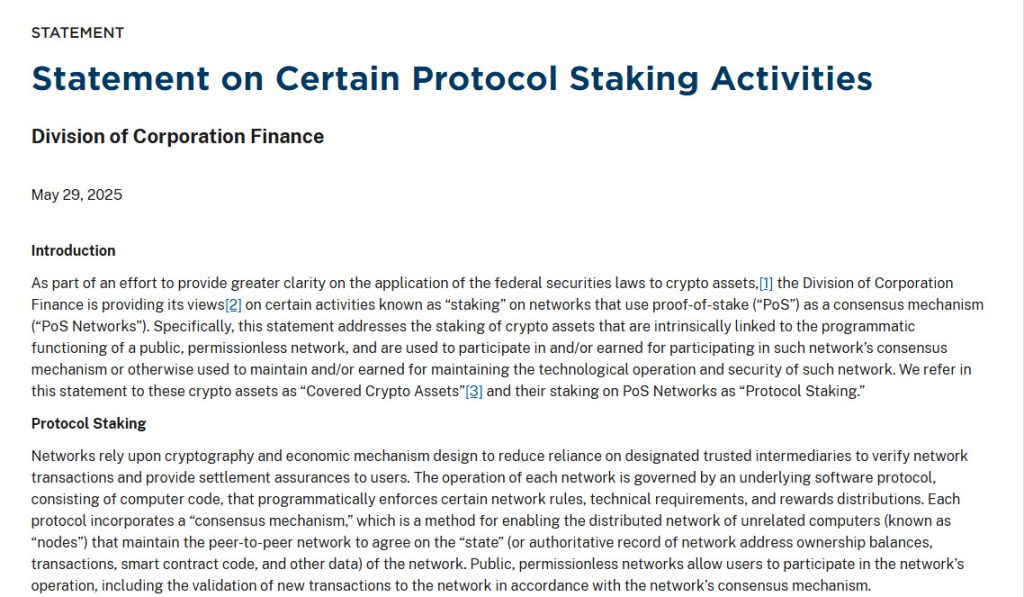Introduction
On May 29, 2025, the US Securities and Exchange Commission (SEC) issued an important statement on one of the most hotly debated topics in the cryptocurrency industry: staking services. The guidance, authored by the SEC’s Division of Corporation Finance, clarifies the circumstances under which staking activities on networks using the Proof-of-Stake (PoS) algorithm will not be classified as securities. In particular, a view has been expressed that most staking transactions by individual users, either directly or through limited third-party services, do not constitute an “investment contract” under the Howey test.
Source: sec.gov
Key Highlights of the SEC’s Guidance
Three Different Staking Models
According to the SEC’s statement, staking activities are analyzed under three basic models:
- Self (Solo) Staking: The user stakes their assets directly by running a personal node. In this model, the user is in full control and gains are realized directly according to the protocol rules.
- Self-Custodial Staking with a Third Party: The user retains custody of their assets while only delegating validator rights to a third party node operator.
- Custodial Staking: A model where assets are handed over to a custodian (e.g. an exchange or custodial platform) and the staking service is provided by this third party. Here, although the user retains ownership, control passes to the custodian.
Transactions that do not qualify as “Investment Contracts”
The SEC states that the activities in these models do not involve entrepreneurial or managerial decisions, but are merely administrative and technical (ministerial). In particular, it emphasizes that staking service providers are not “decision-makers” but intermediaries that fulfill the rules of the protocol. Most staking scenarios therefore do not meet the fourth criterion of the Howey test, “profiting from the efforts of others”.
Limits on Ancillary Services
The SEC also states that such additional services do not increase the risk of “securities”:
- Slashing Compensation
- Early Unbonding Option
- Alternative Award Calendar
- Aggregation of Assets
However, there is an important caveat: If a platform retains discretion over whether, when, and how much to stake, this may make such transactions securities.
Impact on Altcoin Projects
The SEC’s new approach is particularly important for PoS-based altcoin projects. The effects of the guidance will vary depending on the project type and staking model.
- Ethereum (ETH)
Ethereum’s transition to PoS architecture and the ability to be an individual “validator” is in line with the SEC’s favorable view of solo staking.
For Ethereum ETFs, this announcement could pave the way for staking to be incorporated into ETF structures (on July 17th, Blackrock filed for staking to be added to its Ethereum ETF). Although tax and trust structure issues are still to be clarified, the fact that staking is not treated as securities may further increase corporate participation.
- Solana (SOL)
Solana’s highly efficient and decentralized structure makes solo or delegated staking common.
The SEC’s decision to consider the staking of assets such as Solana within the same scope may pave the way for an increase in Solana-backed investment products.
- Cosmos (ATOM), Polkadot (DOT), Near Protocol (NEAR)
Delegated staking is more common in these networks. Users usually delegate their tokens to third party validators.
This structure is directly in line with the SEC’s definition of “self-custodial with third party” and is excluded from securities coverage.
Reduced regulatory uncertainty may make staking-based reward systems more attractive to users.
- Liquid Staking Based Projects: Lido (LDO), Rocket Pool (RPL), EtherFi (ETHFI)
The SEC explicitly states that structures such as liquid staking and restaking are not covered by these guidelines.
Therefore, regulatory risk remains for projects like LDO, RPL and ETHFI. This is because liquidity tokens issued to the user (such as stETH, rETH) can still be considered investment contracts. The SEC specifically stated that such practices are outside the scope of the guidance for now.
New Opportunities for Institutional Investors and the ETF Space
The SEC’s announcement could be a critical milestone for ETF and fund providers offering staking services. For example, it may now be theoretically possible for Spot ETH ETFs to allow ETH staking in the future. However, tax structures need to be clarified before this step can be taken. Increased regulatory clarity will enable institutional investors to more easily invest in PoS-based assets.
Conclusion
This staking guidance, published by the SEC in 2025, is a long-awaited step of clarity for the crypto industry. Although not legally binding, it paves the way for the industry by making it clear that the agency does not consider such activities as investment contracts.
However, this only applies to certain staking models. Next-generation DeFi applications such as liquidity staking and restaking are still in the gray area. It has been stated that if custodians make any discretionary, timing or rate decisions, their activities may be considered as securities.
In light of these developments, it is critical for institutions offering staking services with PoS-based altcoin projects to align their service models with the SEC’s guidance, both in terms of regulatory risk mitigation and user confidence. If a staking service operates directly on the user’s initiative, within the framework of protocol rules, the SEC no longer considers it a security. This means a more open and predictable regulatory environment for both individual users and staking-based projects.
Disclaimer
This content has been prepared by the Darkex Research Team for informational purposes only. It does not constitute investment advice. All risks and responsibilities arising from your investment decisions are solely your own.




